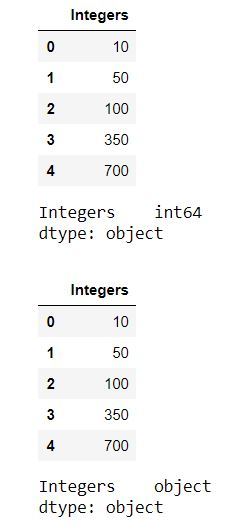How to Convert Integers to Strings in Pandas DataFrame?
Last Updated :
01 Jul, 2022
In this article, we’ll look at different methods to convert an integer into a string in a Pandas dataframe. In Pandas, there are different functions that we can use to achieve this task :
- map(str)
- astype(str)
- apply(str)
- applymap(str)
Example 1 : In this example, we’ll convert each value of a column of integers to string using the map(str) function.
Python3
import pandas as pd
dict = {'Integers' : [10, 50, 100, 350, 700]}
df = pd.DataFrame.from_dict(dict)
print(df)
print(df.dtypes)
print('\n')
df['Integers'] = df['Integers'].map(str)
print(df)
print(df.dtypes)
|
Output :

We can see in the above output that before the datatype was int64 and after the conversion to a string, the datatype is an object which represents a string. Example 2 : In this example, we’ll convert each value of a column of integers to string using the astype(str) function.
Python3
import pandas as pd
dict = {'Integers' : [10, 50, 100, 350, 700]}
df = pd.DataFrame.from_dict(dict)
print(df)
print(df.dtypes)
print('\n')
df['Integers'] = df['Integers'].astype(str)
print(df)
print(df.dtypes)
|
Output :

We can see in the above output that before the datatype was int64 and after the conversion to a string, the datatype is an object which represents a string. Example 3 : In this example, we’ll convert each value of a column of integers to string using the apply(str) function.
Python3
import pandas as pd
dict = {'Integers' : [10, 50, 100, 350, 700]}
df = pd.DataFrame.from_dict(dict)
print(df)
print(df.dtypes)
print('\n')
df['Integers'] = df['Integers'].apply(str)
print(df)
print(df.dtypes)
|
Output :

We can see in the above output that before the datatype was int64 and after the conversion to a string, the datatype is an object which represents a string. Example 4 : All the methods we saw above, convert a single column from an integer to a string. But we can also convert the whole dataframe into a string using the applymap(str) method.
Python3
import pandas as pd
dict = {'Roll No.' : [1, 2, 3, 4, 5], 'Marks':[79, 85, 91, 81, 95]}
df = pd.DataFrame.from_dict(dict)
print(df)
print(df.dtypes)
print('\n')
df = df.applymap(str)
print(df)
print(df.dtypes)
|
Output :

We can see in the above output that before the datatype was int64 and after the conversion to a string, the datatype is an object which represents a string.
Share your thoughts in the comments
Please Login to comment...